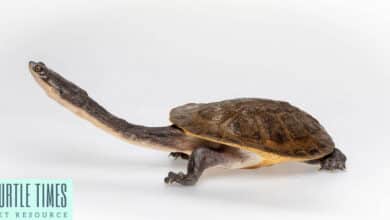Box Turtles & North American Box Turtles
North American Box Turtles
Common name: Box Turtle
Scientific name: T. ornata, Terrapene carolina
Distribution: Eastern & Central United States
Size: 4-7”
Life expectancy: > 40 years
Box turtles are one of America’s favorite turtles. The box turtle is one of America’s most popular turtle pets.
Common / Eastern Box Turtle
Common Box Turtle This is the most common and well-known type of box turtle. “
Common Box Turtle Subspecies:
- Eastern Box Turtle (Terrapene carolina carolina, Linnaeus 1768)
The name is derived from its location in Eastern United States. It is one of the best-known subspecies and has an official status of vulnerable. - Florida Box Turtle (Terrapene carolina bauri, Taylor 1895)
The name comes from the fact that this species is found almost exclusively in Florida. Although it is not a serious threat, it has occasionally been found in Southern Georgia. - Gulf Coast Box Turtle (Terrapene carolina major, Agassiz 1857)
The subspecies can be found in the Gulf of Mexico, between the American states of Louisiana and Florida. - Three Toed Box Turtle (Terrapene carolina triunguis, Agassiz 1857)
This turtle is named after the three toes on its back legs. They are more resistant to new environments and can be kept in a home. - Mexican box turtle
This subspecies is only found in Mexico. There are export laws in place that protect these animals and they are rarely kept as pets. - Yucatan Box Turtle (Terrapene carolina yucatana, Boulenger 1895)
Only the Mexican state Yucatan is home to this subspecies. Although it does not have an official endangered status, locals say they’ve seen fewer of these animals in recent years.
The aquatic box turtle is also called the box turtle
Coahuilan/Aquatic box turtle – this is the only known Water Box Turtle of North America. It is listed as endangered.
Northern and Southern spotted box turtles are subspecies. There is little information about this species. Its name comes from the tiny spots that cover its shell.
Female Northen Spotted Box Turtle. Robert A Villa captured the image from a video. Click here to view the video .
Spotted Box Turtle Subspecies:
- Northern Spotted Box Turtle (Terrapene nelsoni klauberi, Bogert 1943)
- Southern Spotted Box Turtle (Terrapene nelsoni nelsoni, Stejneger 1925)
Western Box Turtle The shell of this species is less dome-shaped. The shell is flatter than that of other box turtles.
Western Box Turtle Subspecies:
Ornate box turtle Patrick Feller’s photograph.
- Ornate Box Turtle (Terrapene ornata ornate, Agassiz 1857)
A subspecies of the Western box turtle. It is officially considered near-threatened. - Desert Box Turtle
This plant is known as a ‘drier state’ because it grows in Texas, New Mexico and Arizona.
Box turtles as pets
They are popular as pets in both their native range and abroad. Box turtles also eat a wide variety of fruits, leaves, and berries.
Box turtles are not dangerous to handle, but will not bite. They are not safe for children.
Box turtles are not suitable as pets for children under five years old. They should be handled by adults calmly and gently. The turtles don’t enjoy being handled by children who move too fast or handle them too roughly. The turtles are stressed by this. Jim Harding is a box-turtle expert at Michigan State University Museum.
Research is important before getting a box turtle as a pet.
Box turtles can be illegal in certain states and countries.
Diet
Box turtles are considered omnivores. The omnivores eat both plants and insects.
Hatchlings need more protein while they are growing. Until they reach adulthood, hatchlings are predominantly carnivores.
Crickets
Most often, box turtles are preyed on by insects. These are small and plentiful. They will eat larger creatures when they are able to.
This is their defense against predators. It is their way of defending themselves against predators.
Wild Behavior
Most box turtles do not travel far from where they were born.
Releasing box turtles in new areas is one of the major causes of their decline. Box turtles will wander aimlessly to find their home.
Box turtles are eaten by raccoons as hatchlings and adults hibernating. Adults are difficult to catch because their shell protects them.
Raccoons and other wild animals can attack box turtles. They are easiest to catch when they are eggs, hatchlings or hibernating. To protect itself from predators, a box turtle will completely seal its shell. Once its limbs are protected, it will pop its heads up to snap an attacker.
Box Turtles are shy creatures that prefer to remain alone. The turtles will hide in logs and brush, or sometimes sand and mud.
Most species/subspecies hibernate during the winter when food is scarcer, and heat is not as readily available.
Behaviour in captivity
The box turtle is not aggressive towards humans and rarely bites. Your fingers’ scent can be deceptive.
Box turtles that are bred in a captivity have a shorter life expectancy. Box turtles that are born in these conditions will be more adapted to life in captivity and less likely to suffer from stress.
It can be a stressful situation.
Health and longevity
Hatchling Box Turtle. Many box turtles will die during their first winter.
During the first winter, many exposed hatchlings die.
Box turtles live on average fifty years in the wild. However, they are reduced to a shorter lifespan when kept captive. Poor care from untrained/uncaring owners has been a contributing factor. Turtles born in captivity that are well-cared for can live just as long as their wild counterparts.
Many hatchlings die during their first winter due to exposure.
HABITAT
- Turtles and hatchlings younger than 3 years old can be kept in a 20-gallon terrarium.
- In winter, box turtles do best when kept outside at temperatures not below 50degF.
- A Box turtle adult will require a minimum of a 30 gallon Terrarium if kept indoors.
- Tortoise Houses are the perfect enclosure for this species. When temperatures allow, the Tortoise House may be moved outdoors to receive natural sunlight.
- If your box turtle is kept indoors, a Tortoise Play Pen can be a great way to provide natural sunlight to the animal and to allow it to graze.
HEATING
- Daytime Terrarium Temperature: 70-80deg F
- The basking spot is 85-87degF
- Temperature at Night: 65-75degF
- For heating the box turtle enclosures, you can use a Basking Spot lamp, Ceramic Heat Emitter or Under Tank Heater.
- Heat Bulbs in Daylight Blue ™, Nightlight Red ™ or both are good sources of supplementary heating.
- The Habitat Heater can be used to heat large enclosures or outdoor turtle homes.
- Thermostats and Rheostats will help you maintain the right temperature.
- Don’t guess the temperature, always use a thermometer!
LIGHTING
- Box turtles need UVB lighting to properly process calcium when in captivity.
- Turtles that do not receive UVB light can develop serious health issues such as Metabolic Bone Disease, abnormal shell growth, and other deformities.
- UVB lighting should be on 10-12 hours a day, and switched off at night.
- Zoo Med’s Linear and Compact Compact Fluorescent Lamps are excellent for UVB. A lamp that provides UVB as well as heat, is a great choice.
- Allow your turtles to bask in the sunshine as much as possible. Always provide an area that is shaded so they can escape from the heat if necessary.
SUBSTRATES
- Box turtles prefer a mixture of Eco Earth (r) and Forest Floor ™.
- Mix 1/3 Zoo Med’s Forest Floor with 1/3 Eco Earth(r) and 1/3 ReptiSand (r) or ReptiFresh (r).
- It is recommended that you provide a 4″+ deep substrate for your turtles to burrow.
- For your turtle, we recommend providing a gradient in moisture. You can create this gradient by placing moistened New Zealand Sphagnum moss and Eco Earth on one side, and Eco Earth or Forest Floor ™ in the other corner. The turtle will switch between the two areas when needed.
NUTRITION
- Box turtles will eat many different foods. They are omnivores who eat at any time. Variety is key to raising healthy box turtles. Box turtles eat a variety of foods, including insects, grasses and fruits. Ornate Box Turtles are more carnivorous and require more protein.
- Add live insects to the mash to encourage turtles who are reluctant to feed.
- To ensure that your turtle is receiving balanced nutrition, it’s important to add ReptiCalcium or ReptiVite to its diet as directed.
- Canned Box Turtle Food can be added to our pelleted food. It is fortified with vitamins and minerals.
- Can O’ Insects makes it easy to offer a wide variety of feeder insects.
- Fruit Mix-Ins make a wonderful treat for box turtles, and they are also a tasty addition to “mash”.
- The Aquatic Tortoise or Turtle Banquet(r), Block is an excellent source of calcium and a supplementary food.
- A Turtle Bone ™ can also help to maintain the beak of your turtle.
- Please be sure to check that the grasses and plants you buy are not treated with pesticides, chemicals or any other substances.
WATER
- Every day, provide fresh water.
- Keep the water level low to prevent accidental drowning.
- Use a water conditioner on all tap water to remove harmful chemicals.
- Keep humidity between 40-50% in the case of adults and 60-70% when it comes to hatchlings.
- Use a hygrometer to monitor the humidity level.
- Offer dampened New Zealand Sphagnum Moss at the cooler end of your enclosure to give your turtle moist burrowing areas.






